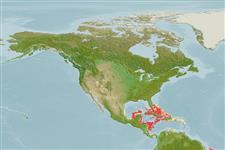>
Gobiiformes (Gobies) >
Gobiidae (Gobies) > Gobiinae
Etymology: Paedovaricus: Name from the root word ‘paed-’ (English spelling of the Greek root ‘ped-’, meaning ‘child’), combined with Varicus, referring to the small size of the type species and its general similarity to the genus Varicus.
More on author: Greenfield.
Environment: milieu / climate zone / depth range / distribution range
Ecología
marino demersal; rango de profundidad 15 - 91 m (Ref. 92840). Tropical
Distribución
Países | Áreas FAO | Ecosistemas | Ocurrencias, apariciones | Point map | Introducciones | Faunafri
Western Atlantic: Eleuthera Islands, Bahamas; Carrie Bow Cay, Belize.
Tamaño / Peso / Age
Maturity: Lm ? range ? - ? cm
Max length : 1.4 cm SL macho / no sexado; (Ref. 92840)
Espinas dorsales (total) : 8; Radios blandos dorsales (total) : 7; Espinas anales: 1; Radios blandos anales: 7; Vértebra: 27. Distinguished by the following characters: possesses all taxonomic characters present in most members of Gobiosomatini and Gobiosoma group (D1 VII, pterygiophore insertion pattern of 3-221110, vertebrae 27 with precaudal 11 and caudal 16, hypurals 1 and are 2 fused to some extent with hypurals 3 and 4 and the terminal vertebral element, 1 epural); pelvic fins are well separated, without both anterior frenum and well-developed membrane connecting innermost rays; pelvic-fin rays 1-5 unbranched, no flattened or fleshy tips; pelvic-fin rays very long, fourth ray extend posteriorly to origin of last anal-fin ray or beyond; scales on body (modified basicaudal scales present); an anal-fin pterygiophore inserted before first haemal spine, no cephalic lateralis canals and pores; D2 I,7; A I,7;body, head, and fins have a light yellowish orange hue, with diffuse dark vertical bars alongside of body, and very dark wide vertical band over posterior end of caudal peduncle and on the base of the caudal rays (Ref. 113825).
Rare in collections that little is known about the distribution and ecology (Ref. 92840).
Life cycle and mating behavior
Madurez | Reproducción | Puesta | Huevos | Fecundidad | Larva
Smith, C.L., 1997. National Audubon Society field guide to tropical marine fishes of the Caribbean, the Gulf of Mexico, Florida, the Bahamas, and Bermuda. Alfred A. Knopf, Inc., New York. 720 p. (Ref. 26938)
IUCN Red List Status (Ref. 130435: Version 2024-2)
Threat to humans
Harmless
Human uses
Herramientas
Special reports
Download XML
Fuentes de Internet
Estimates based on models
Preferred temperature (Ref.
123201): 23.6 - 27.6, mean 25.7 °C (based on 47 cells).
Phylogenetic diversity index (Ref.
82804): PD
50 = 1.0000 [Uniqueness, from 0.5 = low to 2.0 = high].
Bayesian length-weight: a=0.00724 (0.00339 - 0.01546), b=3.10 (2.92 - 3.28), in cm total length, based on LWR estimates for this (Sub)family-body shape (Ref.
93245).
Nivel trófico (Ref.
69278): 3.0 ±0.3 se; based on size and trophs of closest relatives
Resiliencia (Ref.
120179): Alto, población duplicada en un tiempo mínimo inferior a 15 meses (Preliminary K or Fecundity.).
Fishing Vulnerability (Ref.
59153): Low vulnerability (10 of 100).
